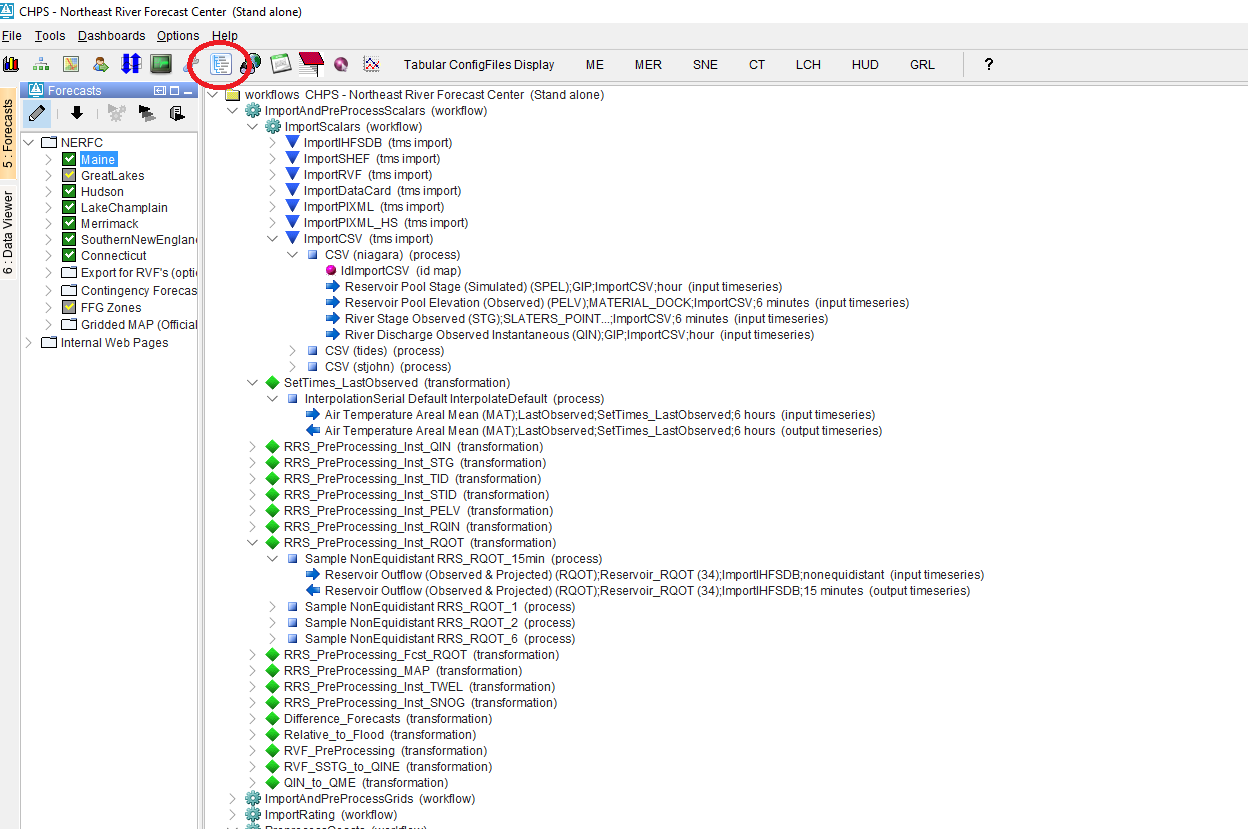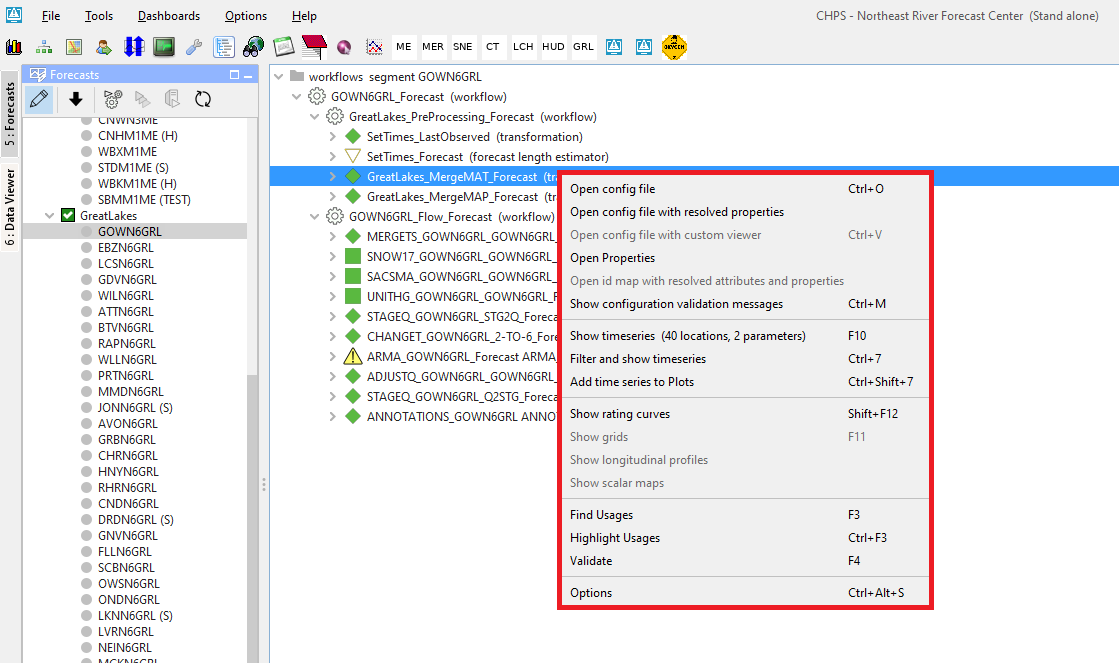
The Workflow Navigator (WN) is a helpful tool for understanding the hierarchical structure of your workflows and all underlying modules, module-instances and incoming/outgoing timeseries. It can also highlight the usage of specific timeseries throughout your config so that you can 'trace' where data is produced and (re)used. The WN displays workflows in a clickable tree-structure so you can navigate and drill down into a workflow towards timeseries level and even inspect the series in a graph or spatial plot.

The Workflow Navigator (WN) can be started in two ways.
When you start the WN from the <F12> menu, all available (visible) workflows will be visualised in the tree-structure. The WN itself opens in a "Worflow Navigator" Tab and can be (un)docked like all other tabs.
When you start the WN from the Explorer taskbar it will 'listen' to the selected workflow in e.g. your topology (forecast tree). Only that workflow will then be visible in the Workflow Navigator tab.
All relevant logging will appear in the Delft-FEWS Explorer log panel. From version 2018.02 (and higher) the log panel has been removed from the Workflow Navigator tab and is now centrally available in the Delft-FEWS Exporer log panel.
The Workflow Navigator (WN) displays the structure of the workflows in a clickable tree-structure. By selecting the nodes of this tree, it expands and underneath the different parts (steps) of the workflow(s) will be recognizable based on its confuration files. Drilling down into this structure, the user is enabled to see all the different (related) configuration files (and inspect them) even down to the input and output timeseries of individual 'steps' of the selected workflow.
When you hover over a node in the structure, the tooltip displays the corresponding configuration file and even displays additional information for transformation elements (when configured in the <description>)
When temporary timeseries are part of your configuration, they are displayed in italics.

In the clickable tree-structure different icons are used. The table below explains the different icons used.
| Icon | Description |
|---|---|
| Workflow (general) |
| Timeseries import module |
| General adapter module |
| Transformation module |
| Old Transformation module |
| Error module |
| Threshold event crossing module |
| Forecast length estimator module |
| Process (any) |
| Unit conversion (process level) |
| Id mapping (process level) |
| Module parameters (process level) |
| Input timeseries (process level) |
| Output timeseries (process level) |
Context-menu options
When you open the Workflow Navigator (WN) , select a certain node and press the right mouse button, the context menu will be visible.

Depending on the hierarchy in the structure and node-type different options are available. Below mentioned table explains the different options.
| Context-menu option | Shortcut | Functionality |
|---|---|---|
| Open config file | Ctrl+O | Opens the corresponding configuration file (in a text-editor) |
| Open config file with resolved properties | Shows both the original module config file and the module config file with resolve properties ( in a comparison window) | |
| Open config file with custom viewer | Ctrl+V | Opens the corresponding configuration file (in a custom viewer) - Module parameters only |
| Open properties | Shows the values of the configured properties (variables between $-characters in a configuration file) | |
| Open id map with resolved attributes and properties | Shows the completed Idmap file in which the references to attributes and/or properties have been filled in. | |
| Show messages | Ctrl+M | Shows the WARN or ERROR messages of the selected item (Workflow or ModuleInstance) |
| Show timeseries (n locations, m parameters) | Ctrl+6 | Opens a Timeseries dialog (TSD) for all n locations and m parameters in one plot |
| Filter and show timeseries | Ctrl+7 | Enables the user to select from a collection of timeseries based on location and module-instance(s). After selection a new plot window is opened showing the selected timeseries |
| Add timeseries to plots | Ctrl+Shift+7 | Enables the user to select from a collection of timeseries based on location and module-instance(s). After selection. the seleced timeseries are added to the selected plot in the Timeseries display. |
| Show rating curves | Ctrl+8 | Shows the rating curve in a plot (if selected timeseries contains a rating curve) |
| Show grids | Ctrl+9 | Opens the spatial display to visualize the selected grid timeseries (only if selected timeseries is a grid) |
| Show longitunidal profile | Shows the longitunidal profile in a plot (if selected timeseries is a longitunidal profile) | |
| Show scalar maps | ||
| Find Usages | F3 | Based on the selected node, it finds identical references throughout the complete workflow list. The result is displayed in a separated panel. Pressing <ESC> cancels the selection. |
| Highlight Usages | Ctrl+F3 | Based on the selected node, the WN tree structure highlights similar references: bold means exact match, black means location match and greyed-out means no match. Pressing <ESC> cancels the selection. |
| Validate | F4 | Validates the selected node (which refers to a configuration file) against the corresponding schema. The log panel displays the result of this validation. |
| Options | F11 | Option to select to show "both visible and invisible workflows" or "only visible workflows". This setting is set in / read from the workflow descriptors configuration file. |